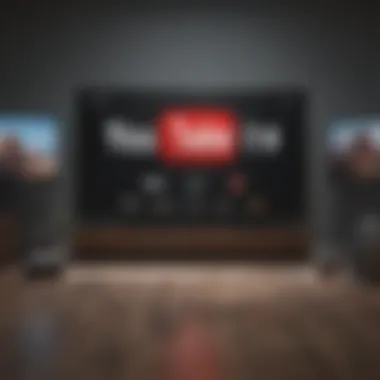YouTube TV and Roku: An In-Depth Analysis of Their Impact


Intro
The landscape of content consumption is altering rapidly, reflecting the shifts in viewer preferences and the rise of new technologies. YouTube TV and Roku stand at the forefront of this transformation, each offering unique features and capabilities that cater to diverse audience needs. This article will provide a thorough analysis of these platforms, covering aspects such as functionality, compatibility, and their impact on media consumption trends. Whether you are a potential user or an investor looking for insights, this guide aims to clarify the roles these services play in current market dynamics.
Market Overview
Current Market Sentiment
The market sentiment surrounding YouTube TV and Roku is a reflection of their growing influence in the streaming industry. Recent studies show increasing user adoption rates, propelled mainly by cord-cutting trends. Many consumers are moving away from traditional cable subscriptions, seeking more flexibility and variety in their viewing options. The platforms are positioned to thrive in this environment, as viewers increasingly demand control over their content choices.
Major Indices Performance
Analyzing the performance of relevant financial indices showcases the overall market appetite for streaming services. Roku, as a publicly traded company, has experienced notable fluctuations in stock prices. These changes often mirror broader trends in tech stocks, influenced by consumer sentiment and competition from other platforms. Understanding how Roku's shares perform in the market provides context for potential investors interested in streaming services.
Economic Indicators Analysis
Economic indicators can significantly impact viewer habits and, subsequently, the performance of YouTube TV and Roku. Metrics such as unemployment rates and disposable income levels inform us about consumers' willingness to invest in subscription-based services. As the economy improves, disposable income takes a positive turn, leading to an increase in subscriptions for over-the-top platforms. Thus, tracking these indicators is essential for evaluating the growth potential of both YouTube TV and Roku.
Features of YouTube TV and Roku
YouTube TV
YouTube TV is a service offering live and on-demand content from various networks. It features a robust channel lineup, including major broadcasters and cable channels. The platform integrates seamlessly with Google's ecosystem, allowing users to easily access content across devices. Additionally, the unlimited cloud DVR storage is a significant advantage for those who prefer to watch shows on their schedule.
Roku
Roku is primarily a media streaming device, but it has evolved into a platform that provides a wide range of channels and services. Users can access content through various apps, including YouTube TV, Netflix, and Hulu. The device is known for its user-friendly interface and compatibility with multiple streaming formats. Roku also features customizable content recommendations, which enhance the viewing experience.
Implications for Viewers
The emergence of YouTube TV and Roku affects viewer habits significantly. The flexibility and customization offered have led to more tailored viewing experiences. This shift is not just about consuming content but rather how users interact with it. Traditional viewing habits centered around scheduled programming are declining, paving the way for on-demand consumption and binge-watching.
The integration of advertising strategies on these platforms also signals a change in how brands engage with consumers. As viewers spend more time on these services, advertisers find new ways to reach them, often using data-driven approaches to maximize ad effectiveness.
“The evolution of platforms like YouTube TV and Roku reflects the broader narrative of media consumption, highlighting a shift towards unprecedented viewer autonomy.”
Culmination
This article will continue to dissect the individual strengths and weaknesses of YouTube TV and Roku, diving deeper into their market positioning, financial implications, and what they mean for the future of content consumption. Understanding these platforms will empower both consumers and investors to make informed decisions in a rapidly changing media landscape.
Overview of YouTube TV
Understanding YouTube TV is critical for comprehending the shifting dynamics of content consumption today. This service has emerged as a significant player within the broader landscape of streaming platforms. It offers a combination of traditional television features, coupled with the accessibility and flexibility that modern viewers demand.
Service Preamble


YouTube TV launched in 2017 as a live TV streaming service, setting out to provide an alternative to traditional cable subscriptions. It combines over 85 channels, enabling users to watch live broadcasts from major networks like ABC, NBC, and CBS. This service appeals to a diverse audience seeking a cable-like experience without the commitment and constraints of conventional cable packages.
Subscription Costs and Packages
Subscriptions to YouTube TV come with a monthly fee that is competitive relative to traditional cable. As of 2023, the base plan starts around $72.99 per month. This includes unlimited DVR storage space, which enables users to record their favorite shows for later viewing. Additional channel add-ons are available, allowing users to customize their subscriptions further, although these come at extra costs.
Channel Selection and Offerings
The channel selection on YouTube TV is robust. It features popular networks covering news, sports, entertainment, and family programming. Subscribers can access channels like ESPN, CNN, and Discovery Channel, making it an attractive option for various viewing preferences. Additionally, the service includes local channels in many areas, allowing users to stay connected with regional news and events.
User Interface and Experience
YouTube TV presents a user-friendly interface that is simple yet effective. Navigation is straightforward, allowing users to search for content easily. The homepage reflects trending shows, recommended content based on viewing history, and a well-organized library for recorded programs. This enhances the overall experience, ensuring viewers can find what they want with minimal effort.
Content Accessibility and Streaming Quality
Content accessibility on YouTube TV is commendable. The service is available on various devices, including smart TVs, mobile phones, tablets, and streaming dongles. It offers streaming in high definition, with most channels available in 720p to 1080p. Nevertheless, the actual streaming quality can depend on network conditions, which is critical for users with varying internet speeds.
"The combination of flexible subscription plans and extensive channel offerings positions YouTube TV as a viable alternative in the ever-evolving landscape of streaming media."
In summary, YouTube TV represents a significant shift in how viewers access and consume media. Its flexibility, channel variety, and user interface make it an appealing choice for consumers looking to cut the cord on traditional cable channels.
Deep Dive into Roku
The exploration of Roku in this article serves multiple purposes. First, Roku has a significant place in the streaming landscape. Understanding its features and offerings gives insights into how it competes with other platforms like YouTube TV. Second, Roku’s user base is expanding. This makes it essential to analyze its technologies, compatibility, and overall ecosystem. Lastly, for potential investors, the value of Roku's market positioning and its adaptability in an evolving media environment is crucial.
Understanding Roku's Ecosystem
Roku operates in a unique ecosystem that involves devices, streaming platforms, and a user interface. Its core offering is the Roku device, which acts as a medium to access various streaming services. These devices range from built-in smart TVs to standalone streaming sticks. Roku's ecosystem promotes flexibility. Users can choose from a variety of devices based on their needs and budget.
The platform supports both free and paid channels. These channels give users access to diverse content, from classic movies to live sports events. For a user, this means access to a wide range of viewing options at their fingertips, resulting in a highly personalized experience.
Additionally, Roku provides a simple, intuitive interface. This ease of use invites a broader audience. Even those with limited technical skill can navigate content. Therefore, understanding its ecosystem is key for anyone interested in the streaming market.
Roku Devices: A Comprehensive Overview
Roku offers various devices that allow users to access content easily. The most common devices include Roku Express, Roku Streaming Stick, and Roku Ultra. Each one has distinct specifications that cater to different user needs.
- Roku Express: This is the entry-level option. It provides excellent value for those new to streaming. It supports HD resolution and includes essential features without unnecessary complexity.
- Roku Streaming Stick: This device is portable. It attaches directly to the TV’s HDMI port. Content rendering is smooth, and it supports 4K resolution and HDR.
- Roku Ultra: For serious streamers, this option includes advanced features like voice control and Ethernet connection. It supports 4K HDR content and offers a premium viewing experience.
Having multiple devices underlines Roku's commitment to accessibility. Users can choose according to their preferences and budget, making it an essential player in the streaming market.
Roku OS Features and Benefits
The Roku Operating System (OS) has several distinguishing features. First, its interface is user-friendly. It allows for easy navigation among channels and content, enhancing user experience. Users can customize their homepage with their favorite channels for quicker access.
Other benefits include:


- Search Functionality: Roku allows users to search across multiple channels for content. This feature facilitates the discovery of shows or movies without evaluating each service separately.
- Private Listening: Using the Roku mobile app, users can listen through headphones. This is beneficial for focusing without disturbing others.
- Voice Control: Many Roku devices include voice control functionality. This enhances accessibility for all users, especially those who prefer hands-free operation.
Overall, Roku OS's features significantly contribute to user satisfaction and retention.
Integration with Streaming Services
Roku’s compatibility with major streaming services is central to its value proposition. It offers access to popular platforms such as Netflix, Hulu, and Disney+. This wide range of service integration makes it appealing for users who seek content diversity.
Moreover, Roku does not limit users to a specific content provider. This openness allows users to mix and match according to their viewing preferences. The seamless integration fosters a cohesive viewing experience.
What makes Roku stand out is also its support for newer services. As fresh platforms emerge, Roku makes them accessible. This adaptability signifies Roku's commitment to remaining relevant in a fast-paced industry.
Content Discovery and Recommendations
One of the crucial aspects of streaming is content discovery. Roku has dedicated features to assist users in finding new content. One such feature is the
Comparative Analysis of YouTube TV and Roku
The comparative analysis of YouTube TV and Roku is fundamental to understanding the evolution of content consumption in today's digital landscape. Both platforms play a significant role in providing viewers with varied options for accessing entertainment. This section will explore key elements that define the user experience, engagement, and positioning of these services.
User Demographics and Target Audiences
User demographics of YouTube TV and Roku vary significantly, impacting their growth strategies. YouTube TV primarily attracts a younger audience, particularly millennials and Gen Z users. This demographic values flexibility and on-demand content. In contrast, Roku appeals to a broader age range, often attracting families and older adults who appreciate the simplicity and diversity of content aggregation. This understanding of target audiences aids in tailoring marketing efforts and service offerings.
Usage Trends and Engagement Metrics
Looking at usage trends, YouTube TV's live streaming feature fosters real-time engagement, while Roku's device interface supports endless browsing. Data analytics indicate YouTube TV users spend more time on live broadcasts versus Roku users, who enjoy catching up on various shows at their leisure. The engagement metrics are revealing; YouTube TV thrives during major events such as sports and award shows, while Roku sees spikes during binge-watching weekends.
Monetization Strategies
Both platforms adopt distinct monetization strategies. YouTube TV follows a subscription model with no ads on the paid tier, focusing solely on user subscriptions. Roku, on the other hand, blends hardware sales with ad-supported content. Advertisers can find value in both, yet the ad strategy varies greatly. YouTube TV relies on network partnerships, while Roku utilizes data-driven ad placements to enhance revenue.
Advertising Opportunities and Challenges
Advertising dynamics also differ. YouTube TV offers advertisers a unique platform to connect with audiences in live environments, enhancing ad relevance. However, they face challenges in balancing ad load with user experience. Roku faces its obstacles, as it competes with various channels for viewer attention. Nevertheless, its ability to leverage user data for targeted ads presents substantial opportunities.
Market Positioning and Competitive Landscape
In terms of market positioning, YouTube TV is often seen as a direct competitor to traditional cable services, appealing to cord-cutters. Meanwhile, Roku positions itself as an aggregator of multiple streaming services, consolidating user choices. As the competitive landscape evolves, both platforms must adapt to ensure that they respond to shifting viewer preferences and industry trends. Understanding these nuances will be critical for investors looking to engage with these growing segments.
"The comparative strengths and weaknesses of YouTube TV and Roku are crucial for understanding their roles in the future of media consumption."
This comparative analysis sheds light on two formidable players in the streaming industry. By delving into user demographics, engagement metrics, monetization tactics, advertising frameworks, and market positioning, readers can gain valuable insights into their strategic choices and future relevance.
Technical Considerations
Understanding the technical aspects of YouTube TV and Roku is crucial for users who want to maximize their viewing experience. These considerations involve compatibility with devices, network performance, common troubleshooting steps, and the importance of regular updates. Addressing these factors enables users to better enjoy the content offered by these platforms and enhances overall reliability.


Device Compatibility
Device compatibility determines how seamlessly YouTube TV and Roku can be integrated into an individual's home setup. YouTube TV is compatible with a broad range of devices, including Smart TVs, streaming media players, smartphones, tablets, and gaming consoles. This versatility allows users to access their favorite shows and channels across various screens. On the other hand, Roku provides its own line of devices along with support for many third-party gadgets. Roku devices, such as Roku Ultra or Roku Express, offer unique features like voice search and 4K streaming. Users need to ensure that their devices meet the required specifications to use both services effectively, making this an essential consideration in choosing preferred platforms.
Network Requirements for Optimal Performance
For optimal performance of YouTube TV and Roku, a robust internet connection is essential. YouTube TV recommends a minimum download speed of 3 Mbps for standard-definition streaming, while 25 Mbps is ideal for high-definition viewing. In contrast, Roku devices benefit from faster connections, particularly when using channels that stream in 4K. A high-speed router can significantly enhance the viewing experience, reducing buffering times and improving content load speeds. Furthermore, using a wired connection instead of Wi-Fi can improve stability, which is especially crucial for live TV streaming.
Troubleshooting Common Issues
Troubleshooting is a necessary skill for anyone using streaming services. Common issues users face with YouTube TV include playback errors, login problems, and buffering. Solutions vary from checking internet connectivity to restarting devices or apps. For Roku, common issues may involve difficulties with channel loading or remote control responsiveness. Users can often resolve these through simple steps such as restarting the device or ensuring it is updated to the latest software version. Fortunately, both platforms have extensive online resources to assist users in resolving various issues, making troubleshooting more manageable.
Updates and Maintenance
Both YouTube TV and Roku require regular updates to function optimally. These updates can bring new features, enhance performance, and provide security upgrades. YouTube TV usually updates automatically on compatible devices, but users should check for updates manually if issues arise. For Roku, updates are also automatic, but users can enforce updates through the Settings menu. Routine maintenance, such as clearing cache or managing storage, can improve performance and ensure smooth operation. Staying informed about updates helps users take full advantage of enhancements and maintain a high-quality viewing experience.
Understanding these technical considerations can optimize the use of both YouTube TV and Roku, enhancing the overall experience for users.
Future Directions and Trends
Future directions and trends in the streaming industry are crucial to understanding how platforms like YouTube TV and Roku will evolve and adapt. As technology advances and consumer behaviors shift, it is essential for stakeholders to observe these developments closely.
Emerging Technologies Impacting Streaming
The streaming landscape is rapidly changing due to emerging technologies. Here are some of the key technologies shaping the future:
- 5G Technology: The rollout of 5G networks promises to enhance streaming quality with faster speeds and lower latency. This opens up possibilities for high-definition and even 4K streaming without buffering issues.
- Artificial Intelligence: AI is becoming increasingly prevalent in content recommendations and personalized viewing experiences. By analyzing viewer habits, AI can suggest content that resonates more with individual users, improving engagement.
- Virtual Reality (VR) and Augmented Reality (AR): These technologies may redefine how content is consumed. Users might interact with programming in a more immersive manner, changing the traditional viewing experience.
The impact of these advancements will be felt across platforms, ultimately altering how viewers engage with content and how services deliver it.
Shifts in Consumer Preferences
Consumer preferences are evolving, influenced by various factors. Some notable shifts are:
- Content Variety: There is an increasing demand for diverse content, including international programming and niche genres. Users now seek platforms that offer expansive libraries beyond traditional offerings.
- Short-Form Content: Platforms like TikTok and Instagram have popularized short-form videos. Streaming services may need to adapt by incorporating shorter content or bite-sized segments to capture the attention of younger audiences.
- Flexibility in Viewing: Modern viewers prefer on-demand services over linear television. They value flexibility, such as watching content anytime and anywhere, leading to rising subscriptions in platforms like YouTube TV.
These changing preferences underline the importance of adaptability for streaming services to maintain relevance and engage users effectively.
Predictions for Market Developments
Looking ahead, several predictions can be made regarding the streaming market:
- Consolidation of Services: As competition grows, smaller platforms may consolidate or be acquired by larger entities. This could lead to fewer but more comprehensive streaming services.
- Increase in Subscription Prices: As the cost of content creation rises, providers may pass additional costs onto consumers. Users might need to prepare for potential price hikes in subscription fees over time.
- Expansion into International Markets: Many platforms will likely prioritize global expansion to tap into new revenue streams. This trend could lead to an increase in multilingual content and localized programming.
These predictions highlight key areas where stakeholders may need to focus and strategize to navigate an evolving market landscape.
Opportunities for Investors
Investors must pay attention to several opportunities within the streaming sector:
- Investing in Technology Firms: Companies developing innovative solutions for streaming can be promising investment choices. Tech advancements could create fruitful partnerships with platforms like YouTube TV and Roku.
- Supporting Content Creators: Investing in independent content creators or production firms could yield substantial returns. As the demand for unique content rises, investors who back original ideas stand to benefit.
- Positioning for International Growth: Investing in platforms expanding their reach can be strategic. Understanding market dynamics in different regions may uncover profitable avenues.
By recognizing these opportunities, investors can align efforts with the future of media consumption, maximizing potential returns in a competitive field.

